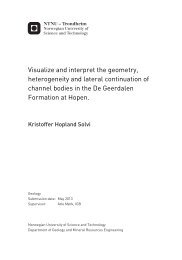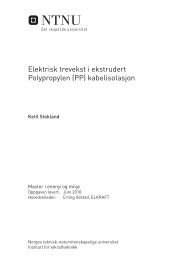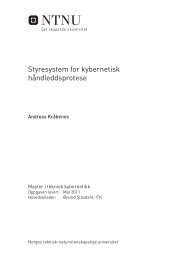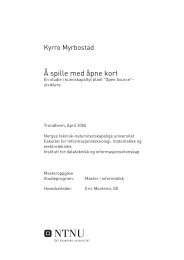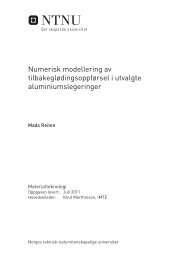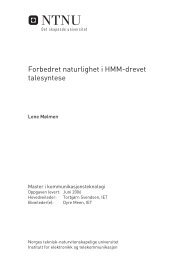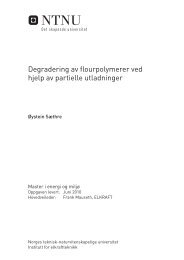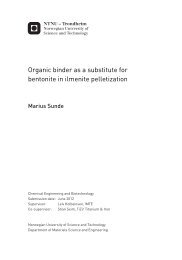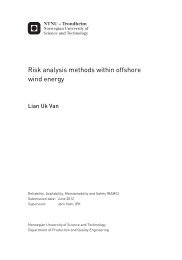Reversible R744 (CO2) heat pumps applied in public trains ... - NTNU
Reversible R744 (CO2) heat pumps applied in public trains ... - NTNU
Reversible R744 (CO2) heat pumps applied in public trains ... - NTNU
You also want an ePaper? Increase the reach of your titles
YUMPU automatically turns print PDFs into web optimized ePapers that Google loves.
ABSTRACT<br />
This report presents opportunities for use of <strong>CO2</strong> as refrigerant <strong>in</strong> the air condition<strong>in</strong>g system<br />
<strong>in</strong> <strong>public</strong> tra<strong>in</strong>s. The <strong>CO2</strong> system shall provide cool<strong>in</strong>g <strong>in</strong> the summer and <strong>heat</strong><strong>in</strong>g <strong>in</strong> the<br />
w<strong>in</strong>ter. <strong>CO2</strong> is a natural fluid which means that it exists naturally <strong>in</strong> the biosphere. Today 75%<br />
of the air condition<strong>in</strong>g systems <strong>in</strong> tra<strong>in</strong>s use R134a as refrigerant. The GWP of R134a is 1410<br />
while <strong>CO2</strong> used as refrigerant is 0. A replacement from R134a to <strong>CO2</strong> gives possibilities of<br />
large environmental sav<strong>in</strong>gs.<br />
Three different technical system solutions of the <strong>heat</strong> pump are presented, each with its own<br />
method of provide cool<strong>in</strong>g and <strong>heat</strong><strong>in</strong>g. Solution I changes between cool<strong>in</strong>g and <strong>heat</strong><strong>in</strong>g by<br />
change the direction of the refrigerant flow through the system. Solution II changes between<br />
cool<strong>in</strong>g and <strong>heat</strong><strong>in</strong>g by change the configuration of the air streams through the <strong>heat</strong><br />
exchangers. In Solution III the refrigerant flow direction and the configurations of the air<br />
streams is always the same. The whole <strong>heat</strong> pump is placed on a rotatable unit and the change<br />
between cool<strong>in</strong>g and <strong>heat</strong><strong>in</strong>g is done by rotat<strong>in</strong>g the whole <strong>heat</strong> pump 180°. In all the three<br />
technical solutions there are separated <strong>heat</strong> exchangers for fresh and exhaust air. This gives an<br />
energy efficient system which recover <strong>heat</strong> from the exhaust air. Computer simulation shows<br />
that a system solution with one evaporation pressure and one stage compression is<br />
problematic for low ambient temperatures; the system must stand temperatures to -40 °C. A<br />
system solution with two levels on the evaporation pressure and a two stage compression<br />
showed to improves the COP from 1,7 to 3,2 when the ambient temperature at -40 °C.<br />
A railway coach need cool<strong>in</strong>g when the ambient temperature is above 20 °C and <strong>heat</strong><strong>in</strong>g<br />
below 15 °C. Norway is a country with cold climate. Weather statistic show that a tra<strong>in</strong> which<br />
drives <strong>in</strong> Oslo every day from 0600 to 1800 throughout a year will need cool<strong>in</strong>g 3% of the<br />
time and <strong>heat</strong><strong>in</strong>g 83% the time. This <strong>heat</strong><strong>in</strong>g should be done by a <strong>heat</strong> pump and not with<br />
electrical <strong>heat</strong><strong>in</strong>g as today. Results of the computer simulation shows that the annual energy<br />
consumption of <strong>heat</strong><strong>in</strong>g the tra<strong>in</strong> will be reduced by 78 % if the designed <strong>CO2</strong> <strong>heat</strong> pump is<br />
used <strong>in</strong> stead of electrical <strong>heat</strong><strong>in</strong>g.



